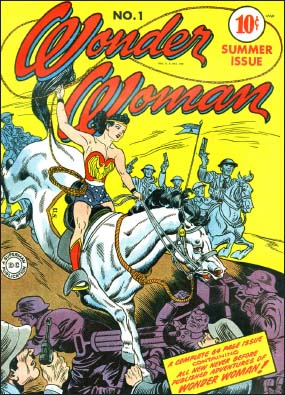Wonder Woman Unbound (23 page)
Read Wonder Woman Unbound Online
Authors: Tim Hanley

*
Statistics side note: These numbers are for the percentage of Wonder Woman’s lasso usage, not for the overall book. Given the shift to campy, fantastical stories in the Silver Age, you might think that Wonder Woman stopped lassoing people and started lassoing spaceships and giant birds instead. This could account for the difference, not the CCA. But when we look at the numbers per issue, we see that while lassoing people dropped from 5 percent of the panels per issue before the CCA to less than 1 percent after, the percentage of panels where Wonder Woman lassoed objects remained at 5 percent for both periods. Objects didn’t replace people; she tied up fewer people but the same number of objects, and the overall drop in the total use of her lasso came from tying up people far less often.

All Star Comics
#8, cover by Everett E. Hibbard, All-American Comics, 1941
The first appearance of Wonder Woman, though she’s not on the cover. She continued to costar in
All Star Comics
as the secretary of the Justice Society.

Sensation Comics
#1, cover by H. G. Peter, All-American Comics, 1942
Wonder Woman’s origin story continued here, launching her new series. Wonder Woman starred in the lead story and on the cover of
Sensation Comics
every month.

Wonder Woman
#1, cover by H. G. Peter, All-American Comics, 1942
Wonder Woman’s solo series. She starred in every story in each issue, which came out quarterly during the Golden Age.

Action Comics
#1, cover by Joe Shuster, Detective Comics Inc., 1938
The first appearance of Superman, the hero who started the superhero craze. Many imitators followed, which led William Moulton Marston to create Wonder Woman as a counter to the genre’s “blood-curdling masculinity.”

Captain America Comics
#1, cover by Jack Kirby, Timely Comics, 1941
The first appearance of Captain America, an American super soldier, punching Hitler before America even entered World War II.

Whiz Comics
#2, cover by C. C. Beck, Fawcett Comics, 1940
The first appearance of Captain Marvel. He was less violent than other heroes but enjoyed demonstrating his superior strength, while Wonder Woman only used force as a last resort.

Wonder Woman sketch by H. G. Peter, 1941
An original design of the character, with notes by Marston and Peter. The skirt was soon replaced by briefs, and the sandals became boots. H. G. PETER; IMAGE COURTESY OF HERITAGE AUCTIONS (
WWW.HA.COM
)

Etta Candy vs. the Cheetah sketch by H. G. Peter, 1943
Etta Candy, the stalwart leader of the Holliday Girls, boxes with the felonious Cheetah. H. G. PETER; IMAGE COURTESY OF HERITAGE AUCTIONS (
WWW.HA.COM
)

The Wonder Woman team, from
Wonder Woman
#2, All-America Comics, 1942
From left to right, writer William Moulton Marston, artist H. G. Peter, editor Sheldon Mayer, and publisher Max Gaines.

The Marstons and friends at home, 1944
From left to right, Marston’s live-in lover Olive Byrne (note the large bracelets), occasional Wonder Woman writer Joye Murchison, Marston’s wife Elizabeth Holloway Marston, and Marston himself. IMAGE COURTESY OF PETE AND CHRISTIE MARSTON

